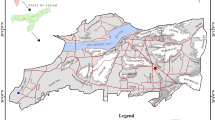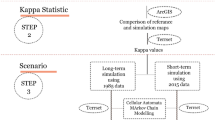Abstract
This study is aimed at analyzing urban change within Istanbul and assessing the city’s future growth potential using appropriate approach modeling for the year 2040. Urban growth is a major driving force of land-use change, and spatial and temporal components of urbanization can be identified through accurate spatial modeling. In this context, widely used urban modeling approaches, such as the Markov chain and logistic regression based on cellular automata (CA), were used to simulate urban growth within Istanbul. The distance from each pixel to the urban and road classes, elevation, and slope, together with municipality and land use maps (as an excluded layer), were identified as factors. Calibration data were obtained from remotely sensed data recorded in 1972, 1986, and 2013. Validation was performed by overlaying the simulated and actual 2013 urban maps, and a kappa index of agreement was derived. The results indicate that urban expansion will influence mainly forest areas during the time period of 2013–2040. The urban expansion was predicted as 429 and 327 km2 with the Markov chain and logistic regression models, respectively.









Similar content being viewed by others
References
Akın, A., Clarke, K. C., & Berberoğlu, S. (2014a). The impact of historical exclusion on the calibration of the SLEUTH urban growth model. International Journal of Applied Earth Observation and Geoinformation, 27, 156–168.
Akın, A., Aliffi, S., Sunar, F. (2014b). Spatio-temporal urban change analysis and the ecological threats concerning the third bridge in Istanbul City. ISPRS Technical Commission VII Symposium.
Almeida, C. M., Batty, M., Monteiro, A. M. V., Camara, G., Soares-Filho, B. S., Cerqueirac, G. C., & Pennachin, C. L. (2003). Stochastic cellular automata modeling of urban land use dynamics: empirical development and estimation. Computers, Environment and Urban Systems, 27, 481–509.
Arsanjani, J. J., Helbich, M., & Mousivand, A. J. (2014). A morphological approach to predicting urban expansion. Transactions in GIS, 18(2), 219–233. doi: 10.1111/tgis.12031
Bagan, H., & Yamagata, Y. (2012). Landsat analysis of urban growth: how Tokyo became the world’s largest megacity during the last 40 years. Remote Sensing of Environment, 127, 210–222.
Batty, M. (1981). Urban models. In N. Wrigley & R. J. Bennett (Eds.), Quantitative geography: a British view (pp. 181–191). London: Routledge and Kegan Paul.
Batty, M., & Xie, Y. (1994). From cells to cities. Environment and Planning B: Planning and Design, 21, 531–548.
Bhatta, B., Saraswati, S., & Bandyopadhyay, D. (2010). Urban sprawl measurement from remote sensing data. Applied Geography, 30(4), 731–740.
Bradley, A. P. (1997). The use of area under the ROC curve in the evaluation of machine learning algorithms. Pattern Recognition, 30, 1145–1159.
Clarke, K. C. (2008). Mapping and modeling land use change: an application of the SLEUTH model. In C. Pettit, W. Cartwright, I. Bishop, K. Lowell, D. Pullar, & D. Duncan (Eds.), Landscape analysis and visualization: spatial models for natural resource management and planning (pp. 353–366). Berlin: Springer.
Clarke, K. C., & Gaydos, L. J. (1998). Loose-coupling a cellular automaton model and GIS: long-term urban growth prediction for San Francisco and Washington/Baltimore. International Journal of Geographical Information Science, 12, 699–714.
Clarke, K. C., Hoppen, S., & Gaydos, L. (1997). A self-modifying cellular automaton model of historical urbanization in the San Francisco Bay area. Environmental and Planning B, 24, 247–261.
Congalton, R. G. (1991). A review of assessing the accuracy of classifications of remotely sensed data. Remote Sensing Environment, 37, 35–46.
Dinamica Project, (2013). http://www.csr.ufmg.br/dinamica/
Erdoğan, N., Nurlu, E., Erdem., Ü. (2011). Modelling land use changes in Karaburun by using CLUE-s. ITU, A|Z, 8, 91-102.
Estoque, R. C., & Murayama, Y. (2012). Examining the potential impact of land use/cover changes on the ecosystem services of Baguio city, the Philippines: a scenario-based analysis. Applied Geography, 35, 316–326.
Eyoh, A., Olayinka, D. N., Nwilo, P., Okwuashi, O., Song, M., & Udoudo, D. (2012). Modelling and predicting future urban expansion of Lagos, Nigeria from remote sensing data using logistic regression and GIS. International Journal of Applied Science and Technology, 2, 116–124.
Foody, G. M. (2001). Status of land cover classification accuracy assessment. Remote Sensing of Environment, 80, 185–201.
Greenel, R., Devillers, R., Luther, J. E., & Brian, G. E. (2011). GIS-based multiple-criteria decision analysis. Geography Compass, 5(6), 412–432. doi:10.1111/j.1749-8198.2011.00431.
He, J., Liu, Y., Yu, Y., Tang, W., Xiang, W., & Liu, D. (2013). A counterfactual scenario simulation approach for assessing the impact of farmland preservation policies on urban sprawl and food security in a major grain-producing area of China. Applied Geography, 37, 127–138.
Hu, Z., & Lo, C. (2007). Modeling urban growth in Atlanta using logistic regression. Computers, Environment and Urban Systems, 31(6), 667–688.
Janssen, L. L. F., & Vanderwel, J. M. (1994). Accuracy assessment of satellite derived land-cover data: a review. Photogrammetric Engineering & Remote Sensing, 60, 419–426.
Kalkhan, M. A., Reıch, R. M., & Czaplewskı, R. L. (1997). Variogram estimates and confidence intervals for the Kappa measure of classification accuracy. Canadian Journal of Remote Sensing, 23, 210–216.
Koomen, E., Stillwell, J., Bakema, A., & Scholten, H. J. (2007). Modelling land-use change; progress and applications. Geojournal library, volume 90. Dordrecht: Springer.
Koukoulas, S., & Blackburn, G. A. (2001). Introducing new indices for accuracy evaluation of classified images representing semi-natural woodland environments. Photogrammetric Engineering & Remote Sensing, 67, 499–510.
Lai, E., Lundie, S., & Ashbolt, N. J. (2008). Review of multi-criteria decision aid for integrated sustainability assessment of urban water systems. Urban Water Journal, 5(4), 315–327.
Landis, J., & Zhang, M. (1998). The second generation of the California urban futures model. Part 1: model logic and theory. Environment and Planning B: Planning and Design, 30, 657–666.
Li, X., & Liu, X. (2006). An extended cellular automaton using case-based reasoning for simulating urban development in a large complex region. International Journal of Geographical Information Science, 20, 1109–1136.
Lillesand, T. M., & Kiefer, R. W. (1994). Remote sensing and photo interpretation (3rd ed.). Wiley: New York. 750 p.
Mahiny, A. S., & Clarke, K. C. (2012). Guiding SLEUTH land-use/land-cover change modeling using multicriteria evaluation: towards dynamic sustainable land-use planning. Environment and Planning B: Planning and Design, 2012(39), 925–944.
Mas, J. F., Soares Filho, B., Pontius, R. G., Jr., Farfán Gutiérrez, M., & Rodrigues, H. (2013). A suite of tools for ROC analysis of spatial models. ISPRS International Journal Geo-Informatiobn, 2(3), 869–887.
Mousivand, A.J., Alimohammadi Sarab, A., Shayan, S., (2007). A new approach of predicting land use and land cover changes by satellite imagery and Markov chain model (case study: Tehran). MSc Thesis. Tarbiat Modares University, Tehran, Iran.
Muller, M. R., & Middleton, J. (1994). A Markov model of land-use change dynamics in the Niagara Region, Ontario, Canada. Landscape Ecology, 9(2), 151–157.
Patino, J. E., & Duque, J. C. (2013). A review of regional science applications of satellite remote sensing in urban settings. Computers, Environment and Urban Systems, 37, 1e17.
Rumelhart, D. E., Hinton, G. E., & Williams, R. J. (1986). Learning representations by back-propagation errors. Nature, 323, 533–536.
Schneider, A., & Woodcock, C. (2008). Compact, dispersed, fragmented, extensive? A comparison of urban expansion in twenty-five global cities using remotely sensed, data pattern metrics and census information. Urban Study, 45, 659–92.
Silva, E. A., & Clarke, C. K. (2005). Complexity, emergence and cellular urban models: lessons learned from appling SLEUTH to two Portuguese cities. European Planning Studies, 13, 93–115.
Swain, P. H., & Davis, S. M. (1978). Remote sensing: the quantitative approach. New York: McGraw-Hill.
Swets, J. (1988). Measuring the accuracy of diagnostic systems. Science, 240, 1285–1293.
TUİK, (2013). Turkish Statistical Institute, http://www.turkstat.gov.tr/
Veldkamp, A., & Lambin, E. F. (2001). Predicting land-use change. Agriculture, Ecosystems and Environment, 85, 1–6.
Verburg, P. H., & Veldkamp, A. (2004). Projecting land use transitions at forest fringes in the Philippines at two spatial scales. Landscape Ecology, 19(2004), 77–98.
Verburg, P. H., Soepboer, W., Veldkamp, A., Limpiada, R., Espaldon, V., & Mastura, S. S. A. (2002). Modeling the spatial dynamics of regional land use: the clue-s model. Environmental Management, 30(3), 391–405.
Waddell, P. (2010). Modelling residential location in UrbanSim, 165-180, Residential location choice: models and applications, Pagliara, F., Preston, J. and Simmonds, D. (Eds.), ISBN: 978-3-642-12787-8, Springer, Advances in Spatial Science Series, 250 p.
Weng, Q. (2001). A remote sensing-GIS evaluation of urban expansion and its impact on surface temperature in the Zhujiang Delta, China. International Journal of Remote Sensing, 22, 1999–2014.
Xie, C., Huang, B., Claramunt, C., Chandramouli, C. (2005). Spatial logistic regression and GIS to model rural-urban land conversion. In: Proceedings of PROCESSUS Second International Colloquium on the Behavioural Foundations of Integrated Land-use and Transportation Models: frameworks, models and applications, June 12–15, 2005, University of Toronto, Canada.
Author information
Authors and Affiliations
Corresponding author
Rights and permissions
About this article
Cite this article
Akın, A., Sunar, F. & Berberoğlu, S. Urban change analysis and future growth of Istanbul. Environ Monit Assess 187, 506 (2015). https://doi.org/10.1007/s10661-015-4721-1
Received:
Accepted:
Published:
DOI: https://doi.org/10.1007/s10661-015-4721-1




